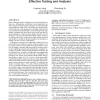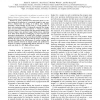79 search results - page 5 / 16 » Finding Failure Causes through Automated Testing |
SIGSOFT
2008
ACM
14 years 8 months ago
2008
ACM
Many testing and analysis techniques have been developed for inhouse use. Although they are effective at discovering defects before a program is deployed, these techniques are oft...
SIGSOFT
2006
ACM
14 years 8 months ago
2006
ACM
Recent software systems usually feature an automated failure reporting system, with which a huge number of failing traces are collected every day. In order to prioritize fault dia...
ASPLOS
2009
ACM
14 years 8 months ago
2009
ACM
Software defects, commonly known as bugs, present a serious challenge for system reliability and dependability. Once a program failure is observed, the debugging activities to loc...
BMCBI
2011
12 years 11 months ago
2011
Background: Flow Cytometry is a process by which cells, and other microscopic particles, can be identified, counted, and sorted mechanically through the use of hydrodynamic pressu...
KBSE
2008
IEEE
14 years 1 months ago
2008
IEEE
Abstract—A poorly understood but important factor in random testing is the selection of a maximum length for test runs. Given a limited time for testing, it is seldom clear wheth...


